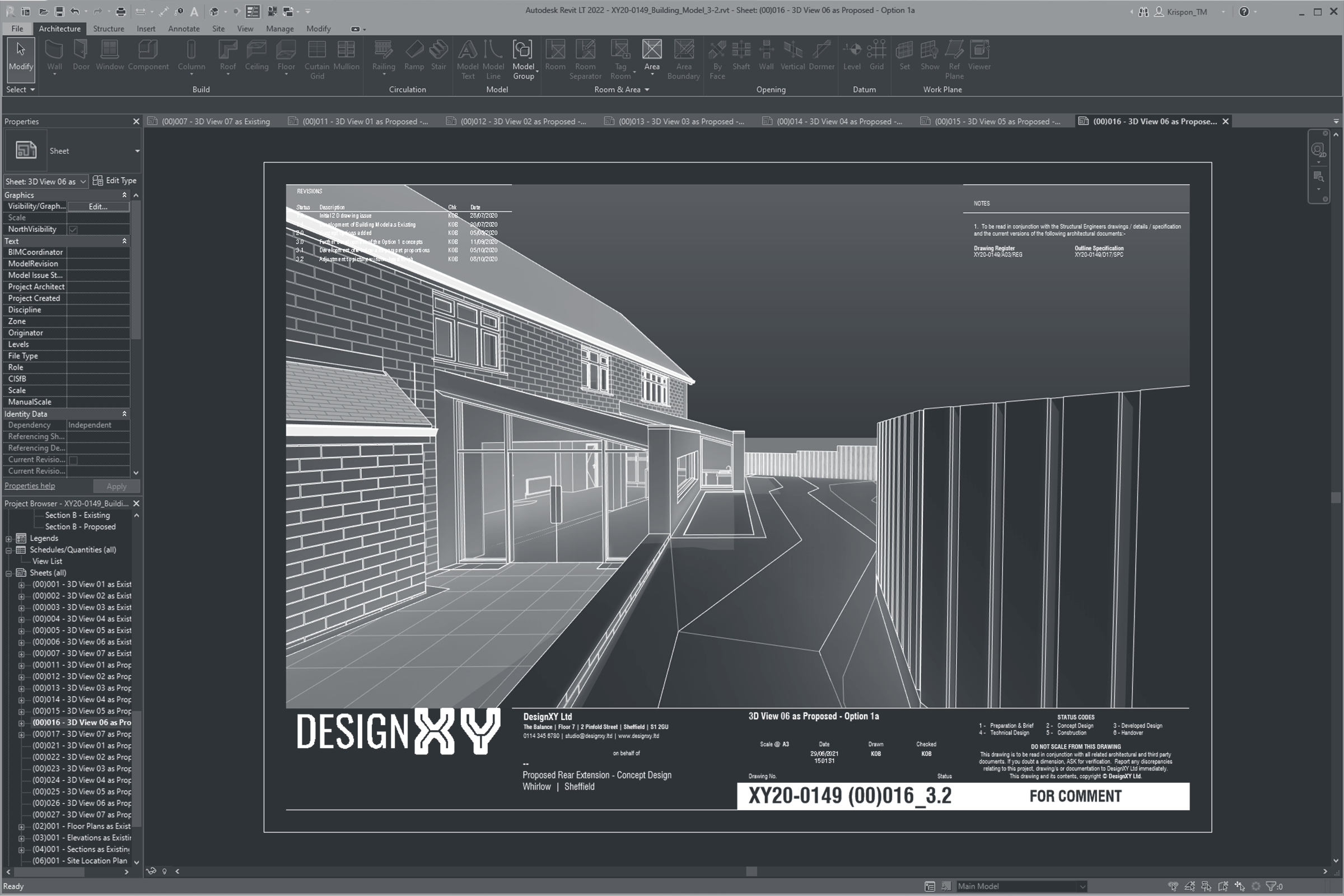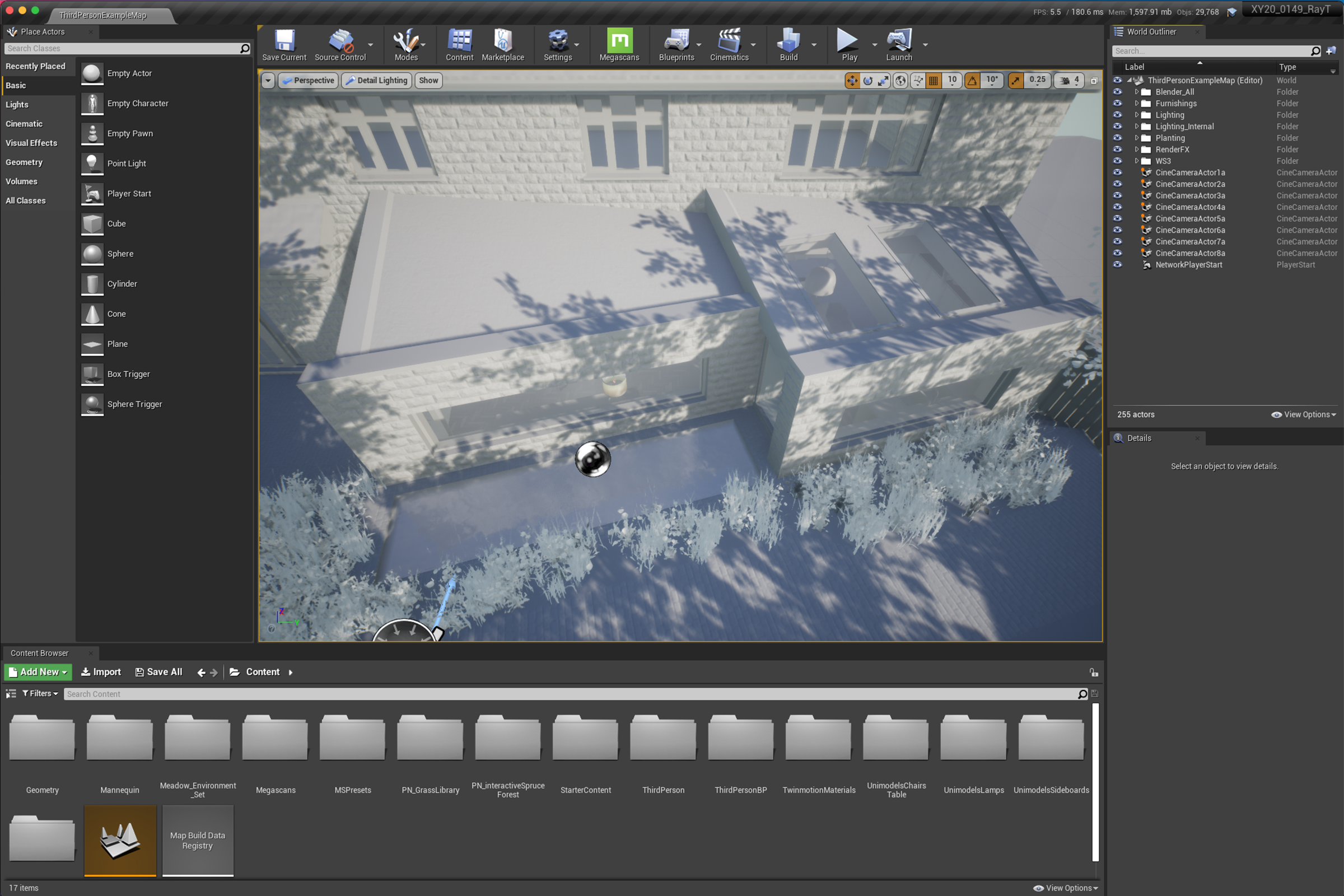Unreal Part 4 : Architecture + Practice [DXY Journal]
DesignXY Ltd Journal, looking in depth at how our architectural practice uses digital technologies to visualise projects to high standards, using software that is increasingly shared with the film and game industry [Part 4/4].
[12min Reading Time]
In Unreal Part 2: Film, we learned of the views of the director of The Mandalorian TV series – specifically his thoughts on the application of ground-breaking new technologies for use by film-makers that may now be encouraged to follow the path that his team had set-out.
“Now that you see somebody could do it, it becomes easier to emulate, because this technology is pretty readily available… it’s just combined in a way that nobody’s done it before and you also have to have an understanding of how to do it.”
Jon Favreau
Favreau recognised the limitations of the existing processes in his industry; the constraints related to time, budget and technology in the film-making process. He asked questions of the right people and tested new tools and processes at a small scale, until a workable and satisfactory production pipeline was established.
Now that the results have been published in the form of the completed first seasons of The Mandalorian, it’s safe to say that the new process, the new paradigm, has been successful. Setting aside any critique of the content of the TV show, the test from a technological perspective is whether the world-building seems real through the lens of the cameras and in turn, on the screens in front of viewers around the world. The critical response to that is yes – perhaps even more deserving of praise in that the particular application of technology was so subtle, it may have gone unnoticed had the production team not documented their process.
In Unreal Part 1: Convergence, I asked two questions of myself.
How can DesignXY continue to improve the services that we offer to our clients?
How can we do that and remain competitive with our fee levels?
When I started SIX Architecture + Design Ltd (my first architectural practice) in 2009, I naively expected that these are questions that architectural directors ask themselves regularly. On my journey to becoming a director at DesignXY Ltd, and based on observations in roles throughout my career in practice from 1995 onwards, my conclusion is that there aren’t enough leaders in the architectural industry (or the wider construction industry) asking themselves these or similar questions.
A 2D plan view of the property as existing; the building model is developed in Revit LT.
A 2D plan view of the property as proposed. Although the information appears to be flat, this is ‘looking down’ into a 3D model.
The first 3D view from Revit LT, shows the house as existing.
This 3D view from Revit LT, shows the house as proposed from the same angle.
An additional perspective view, shows the 3D Revit LT model in the as existing form.
From the same angle, the 3D Revit LT model shows the proposed form of the residential extension project.
There is certainly investment in the pursuit of a winning formula – the process of producing a product or a service that is successful, reliable and in demand.
Jim Collins in his book How The Mighty Fall, offers a number of examples of companies that were once at the top of their industry, but made either poor predictions of what lay just over the horizon, or worse, failed to prepare for any future that involved change of any kind within their organisation.
Collins describes The Doom Loop and the process that previously good or even great companies go through, on their descent to obscurity and irrelevance.
Accepting then that even larger architectural practices don’t necessarily attempt to keep pace with changes in technology, in seeking to keep my own practice towards the leading edge of design capabilities is in some way an answer to the first question, i.e. how can DesignXY continue to improve the services that we offer to our clients.
The second question, i.e. how can we improve our services and remain competitive with our fee levels, is intentionally linked to the first question. The world is changing; the human experience is becoming inextricably linked with technology as an enabler in our lives. As private individuals, it’s our choice as to how much we permit technology to play a part within our lives, but as a business owner, I seek to use technology to streamline and improve the administrative functions of the company, as well as the design processes of the practice.
It’s important to me that the technologies that we use at DesignXY Ltd have been adopted based on recognition of specific needs, as opposed to implementation of software or hardware for its own sake. Throughout the first year of the Covid-19 pandemic, I’ve trialled and rolled out the use of monday.com as the admin platform for the practice – encompassing basic admin functions, but also allowing development of complex automations for tracking internal and external actions. This has allowed me to cover the functions of a director, practice manager and finance officer, as well as keeping project work moving forward.
The same ethos applies at DesignXY Ltd in the application of architectural design technologies.
Acknowledge when we have a problem and define it. Does the problem exist because of something we are / aren’t currently doing? Can we overcome the problem by changing the way we do something? Do we need additional or alternative resources / tools to overcome this issue? So many companies are unwilling to admit that there may be a problem, so they never innovate; their capabilities and their people stagnate.
You may remember that in Unreal Part 1: Convergence, I had been challenged by a consultant colleague with regard to the production of 3D visuals for a specific client. Our colleague had an expectation that we would be able to produce 3D renderings of the buildings within the project; I maintained that while this was possible, we would have to charge for the additional time to add materials, lighting and textures to our basic massing model. Our colleague said that my co-director had done this for him before on a different project at no additional cost – this left us both a little confused as to where we stood with this.
On further investigation, I established that on the previous project, my co-director had simply switched on the ‘realistic’ mode in our standard 3D model – this applied very basic textures and materials to walls and glazing, which as far as our consultant colleague was concerned, was good enough for the job. I inwardly cringed, imagining someone using the images on a website or site hoarding, with our practice name right next to it. The images were just not of a standard that was suitable for marketing purposes, or for impressing clients that are increasingly expectant of higher quality images, presenting a higher level of realism.
So, as with Jon Favreau and the limitations on his story-telling, we had a problem – there was a limitation on our architectural visualisation. The problem existed in part because we didn’t have an established (and agreed) workflow for development of higher-end visualisation, other than to out-source. Investing in software or external talent is costly and we therefore need to be mindful of cost / benefit sensitivities, but also, the client has an expectation that this should be part of the service.
This lead to two further questions.
Can we overcome the problem by changing the way we do something?
Do we need additional or alternative resources / tools to overcome this issue?
After an initial conversation with the consultant colleague and my assertion that this can’t be done without additional time and / or money, I took a few moments to think about this and wonder, what if I’m wrong? How do I apply the core principle in this instance, of big practice capabilities, but small practice attention to detail? If money was not a restricting factor, what would an efficient solution look like?
The answer, as in so many comparable situations, comes through research and development. I began to look for a solution to showcase our architectural work in the best possible ways, preferably allowing for future use of augmented / virtual reality, but in the short term, seeking a more realistic and immersive way of presenting our work to clients and third parties.
Based on the suite of Autodesk design software that we were already using, the obvious additions to explore would be 3DS Max and / or Unity. Vaguely aware of the comparisons between Unity and Unreal Engine, I began to scour the Internet for strong cases for the adoption of either, or for a reason to trial one first ahead of the other. Despite the links that Unity has with the Autodesk family of products, as demonstrated in Unreal Part 3: Gaming, I had direct experience of using end-products from the Unreal Engine pipeline – that was enough to establish Unreal as the starting point.
The Revit LT model, having been imported via Blender, in the Brush Wireframe mode; the vertices and polygons of the model are clearly visible.
The Visibility Collision mode shows everything within the 3D model that Unreal Engine recognises as capable of causing an interaction with other objects.
In the Detail Lighting mode, the texture of the model is also visible, with every bump or variance on a surface creating depth and therefore shadows.
In the Unlit mode, only the colour and texture of the materials are visible, in a uniform wash of light; this makes issues in the model more apparent, when they may otherwise be hidden in shadows.
In the Lit mode of Unreal Engine, the form, colour, texture and lighting come together in the model.
On screen, the model developer can see the impact of the simulated breeze, with the planting swaying gently; this impacts the light rays through the trees, so the projected shadows also move on surfaces.
Although still early in the evaluation process and with relatively few opportunities to explore the full toolset that Unreal Engine offers, there are three projects that have been used for further research and development as to the capabilities of the software. It’s presented a steep learning curve, demonstrating a number of further points for consideration and evaluation in more depth.
Unreal Engine is free to use for projects with commercial values below a prescribed threshold, but there are other software and hardware cost considerations.
In adopting this methodology, we also have to consider whether this is a role for specialists, or a required skill for the whole architectural team?
Although Unreal Engine can be used in a number of modes that reduce the demands on the hardware performance, for real-time interaction with the model, does it makes sense to use the most powerful hardware available?
As Revit LT isn’t developed with a direct input from /output to Unreal Engine, we’ve found that an intermediate step through Blender is also required. As Blender is in itself a highly capable platform for 3D modelling and rendering, is this a worthwhile opportunity to master skills in another software platform, or a distraction?
Unreal Engine offers opportunities to see our architectural designs as high quality renderings, or even explorable environments to our clients. The real-time output of Unreal Engine lends itself to exploration on screen (or via VR goggles) as opposed to a printed medium.
At the time of writing, we haven’t yet had the opportunity to fully evaluate Twinmotion, which is produced by the Unreal Engine development team, specifically for use by architectural practitioners. Our initial view is that it has been streamlined for quick and impressive results on architectural applications, but at the cost of some of the functionality offered by the fully featured Unreal Engine.
Even so, Twinmotion has the backing of high profile practices, such as Zaha Hadid Architects; it may offer the best balance of ease of use, depth of features and speed of production, that would make it the most appropriate overall platform for the production of 3D renderings and environments, in the majority of cases. For more complex needs, the Twinmotion to Unreal Engine Bridge allows for transfer of files between the related platforms without data loss, or time lost to remodelling / remapping elements that don’t transfer with full integrity or fidelity.
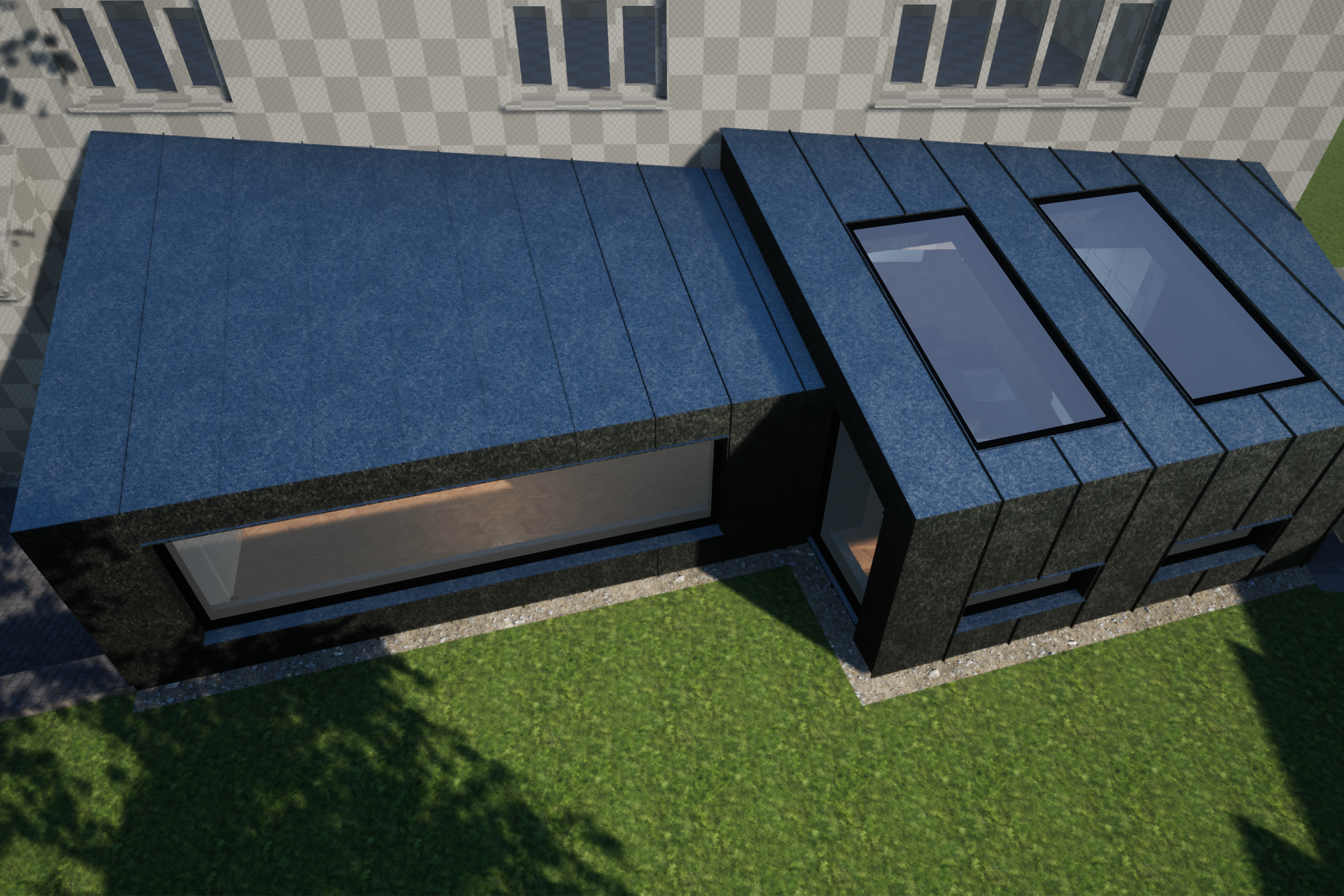
In an early working concept version of the model, the existing building is modelled, but has not yet received any materials on its surface.
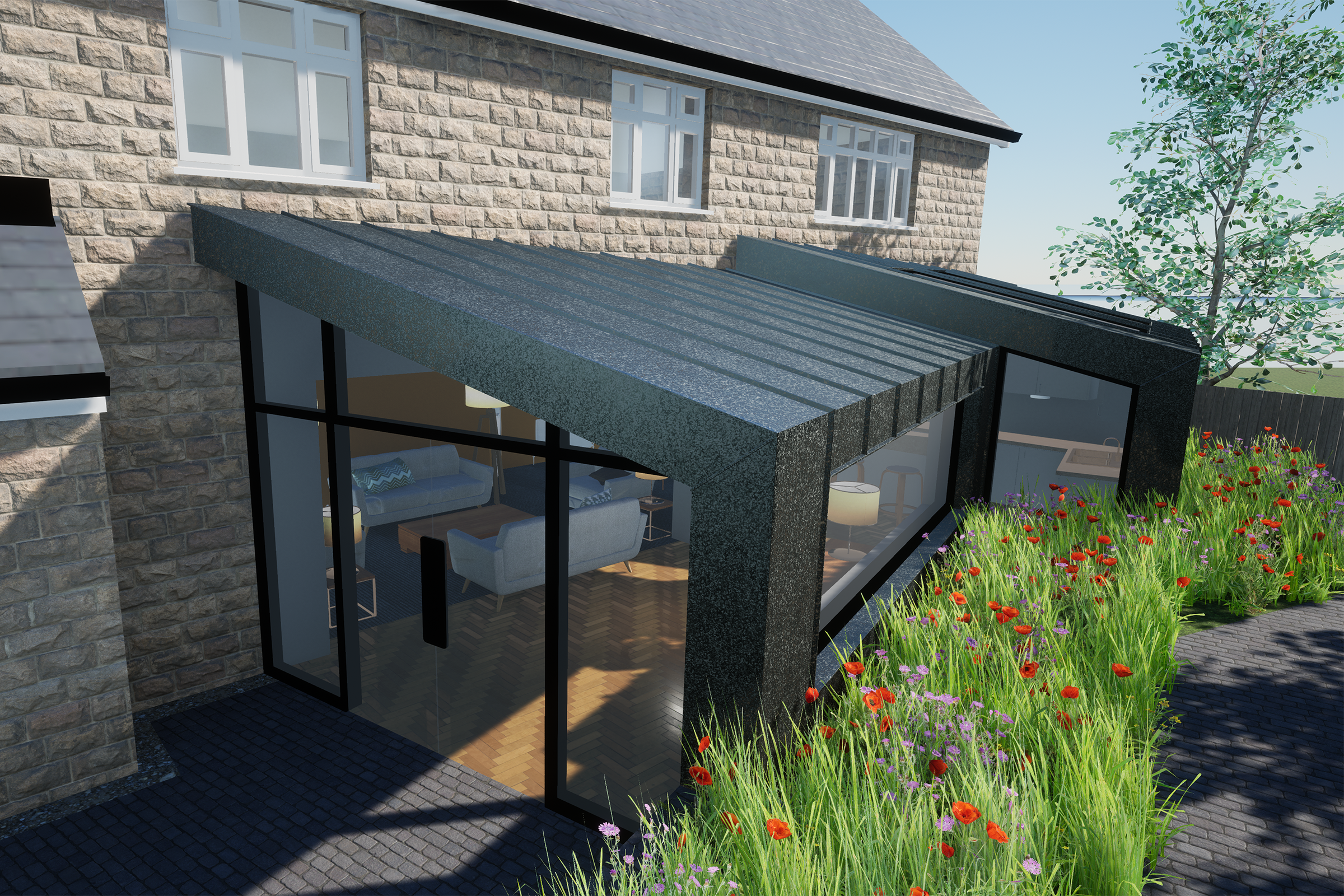
In a more developed state, Option 1 shows a metal standing seam system as the external finish to the residential extension.

A picture window in the wall of the living area serves to frame a dramatic view of the planting.

Smaller windows, with similar proportions to the larger picture window, create more wall space for cupboards in the kitchen.
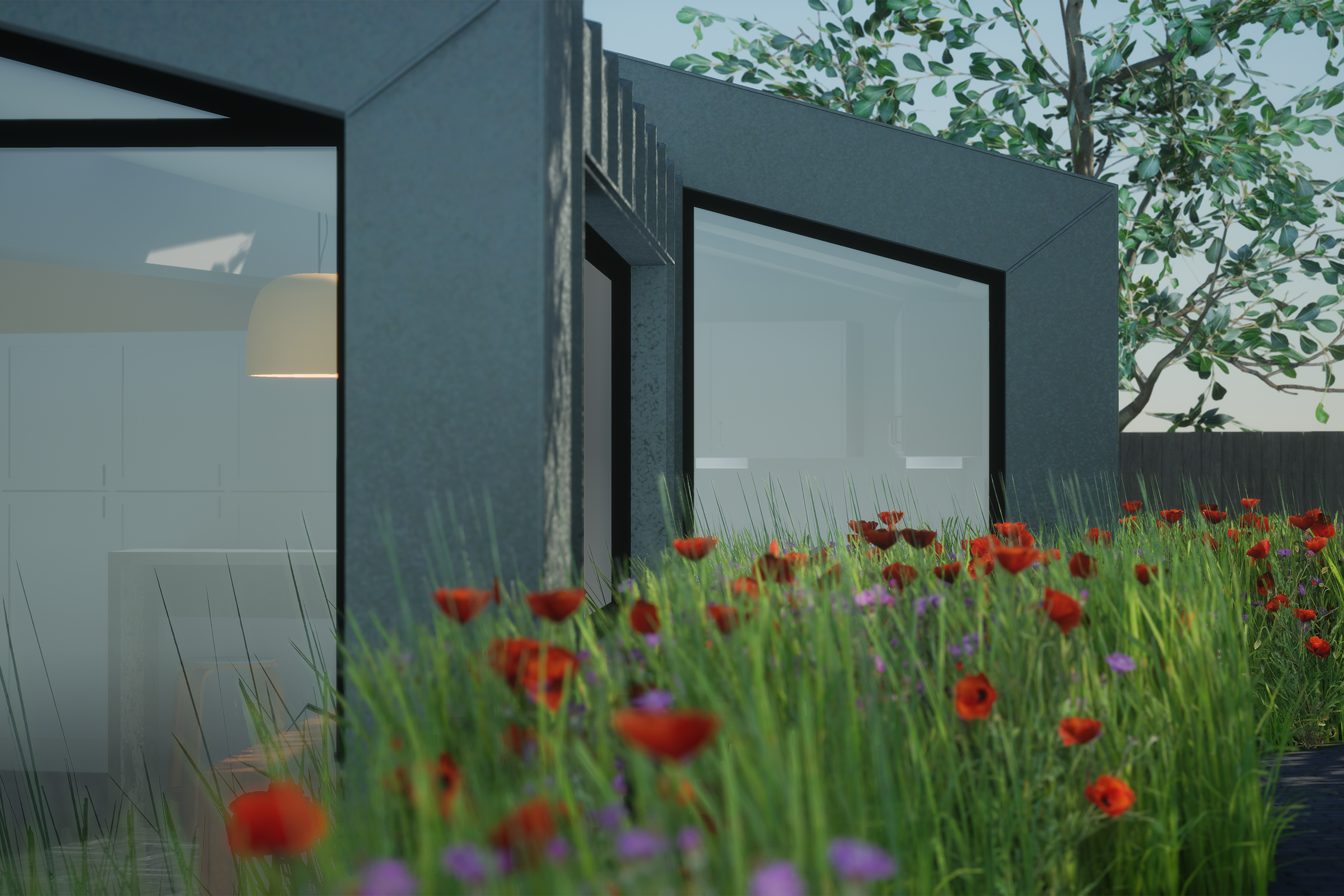
With a cinematic camera set to create the view, the depth of field effect is plainly visible, as are the ribs in the standing seam cladding system.
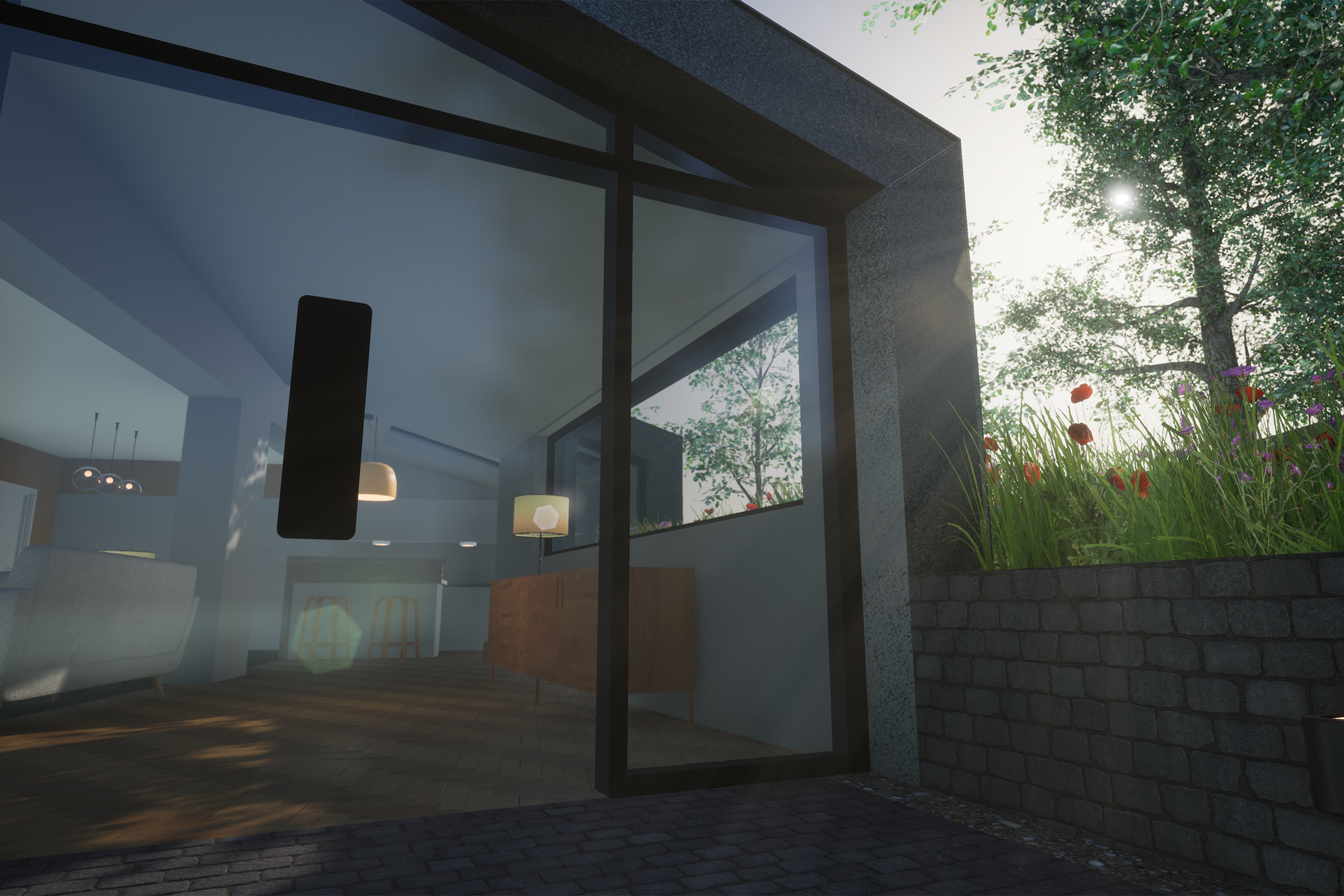
In a mood defining image, atmospheric haze allows the projected rays of the Sun to be seen through the moving branches and leaves of the trees.
Based on the most detailed 3D model that we’ve developed in Unreal Engine to date, our initial client feedback has been very positive.
We specifically developed the model for this client as we were asking them to commit to a somewhat non-conventional form for their home extension. Unreal Engine performed as we hoped it would, when we took the model to the client’s house to provide a live demonstration directly from the software, via a HD projector.
The demo not only allowed us to move around the model in real-time, but the sunlight became a dynamic aspect of the experience, as it projected shadows through the trees and plants, moving gently in the breeze of the dynamic environment.
As a small practice, time is an incredibly precious commodity. On one hand, it may be seen as a luxury to invest resources into research and development such as this, but this is one potential way of responding to a real-world question, i.e. how can DesignXY continue to improve the services that we offer to our clients? More specifically, can we produce higher quality 3D images than those that are produced as standard by Revit LT and if so, can we do this in a way that extends our offer to clients, as opposed to simply generating more work and having to charge higher fees?
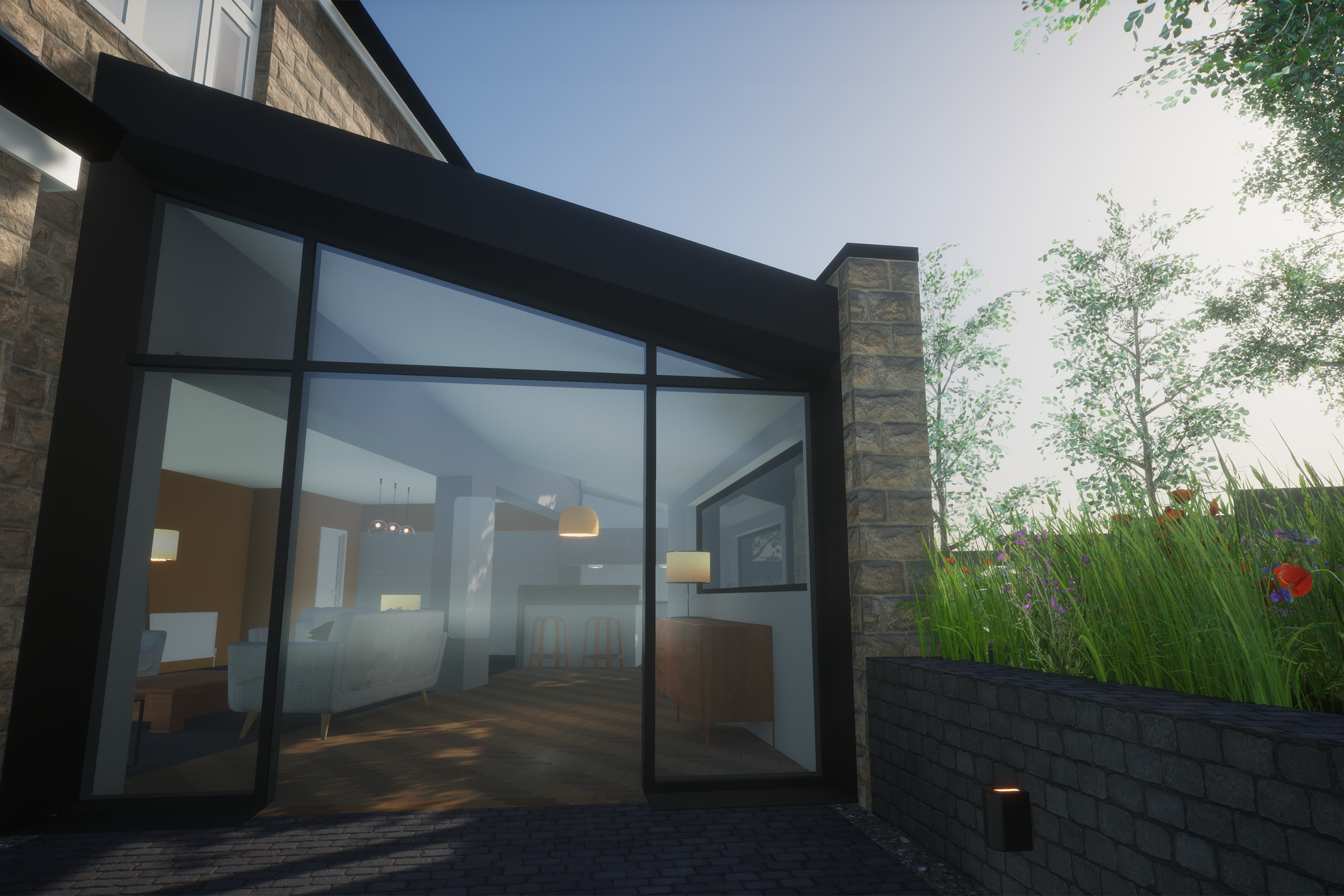
In Option 2, the Client asked to see a stone material as the finish for the proposed residential extension.

In this version of the model, the planes of the outer walls and roof are clearly differentiated, whereas in the previous option they read more as a single element.
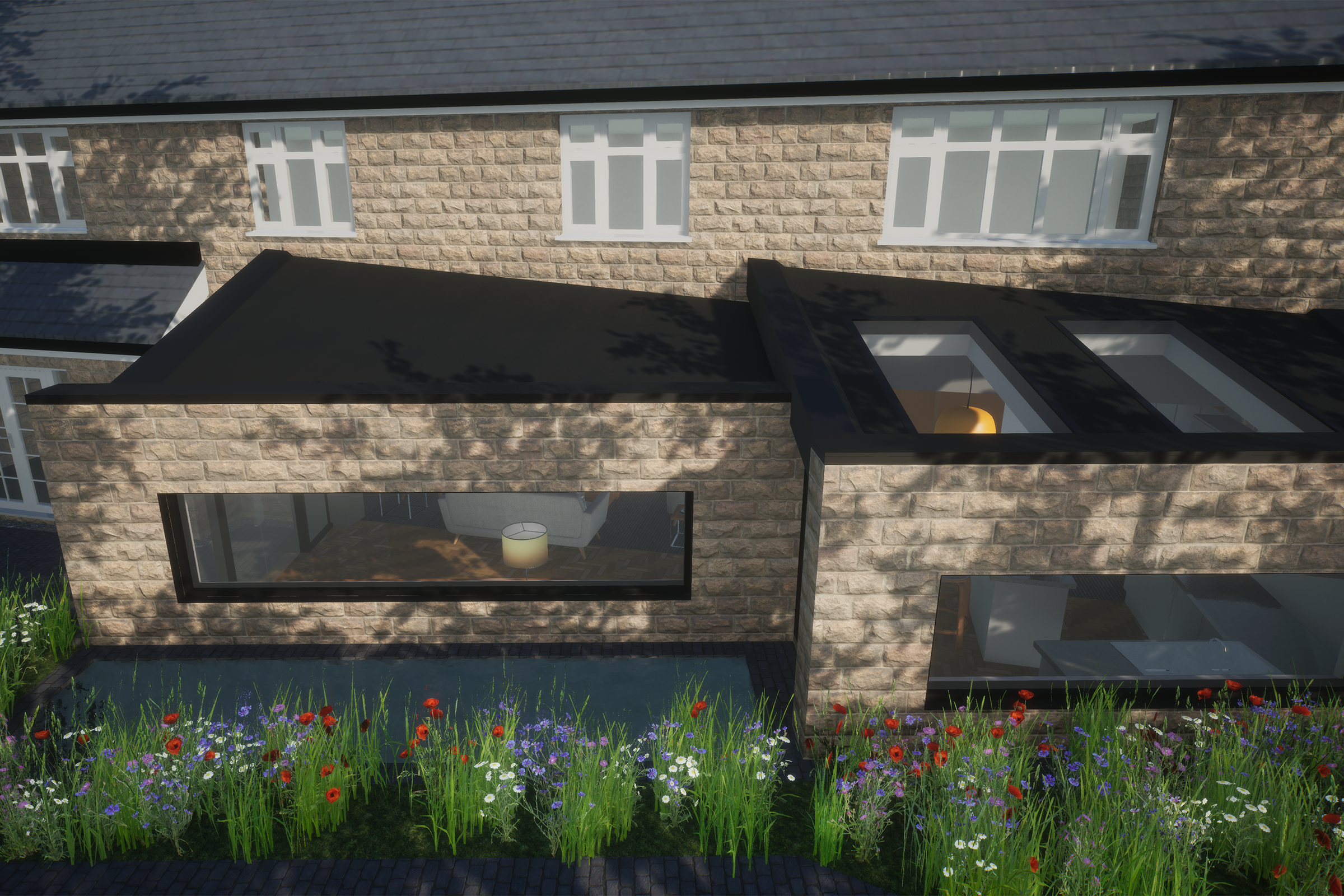
With dark grey frames and capping at parapet level, the stone elements of the proposed extension walls appear to be isolated from the original house.
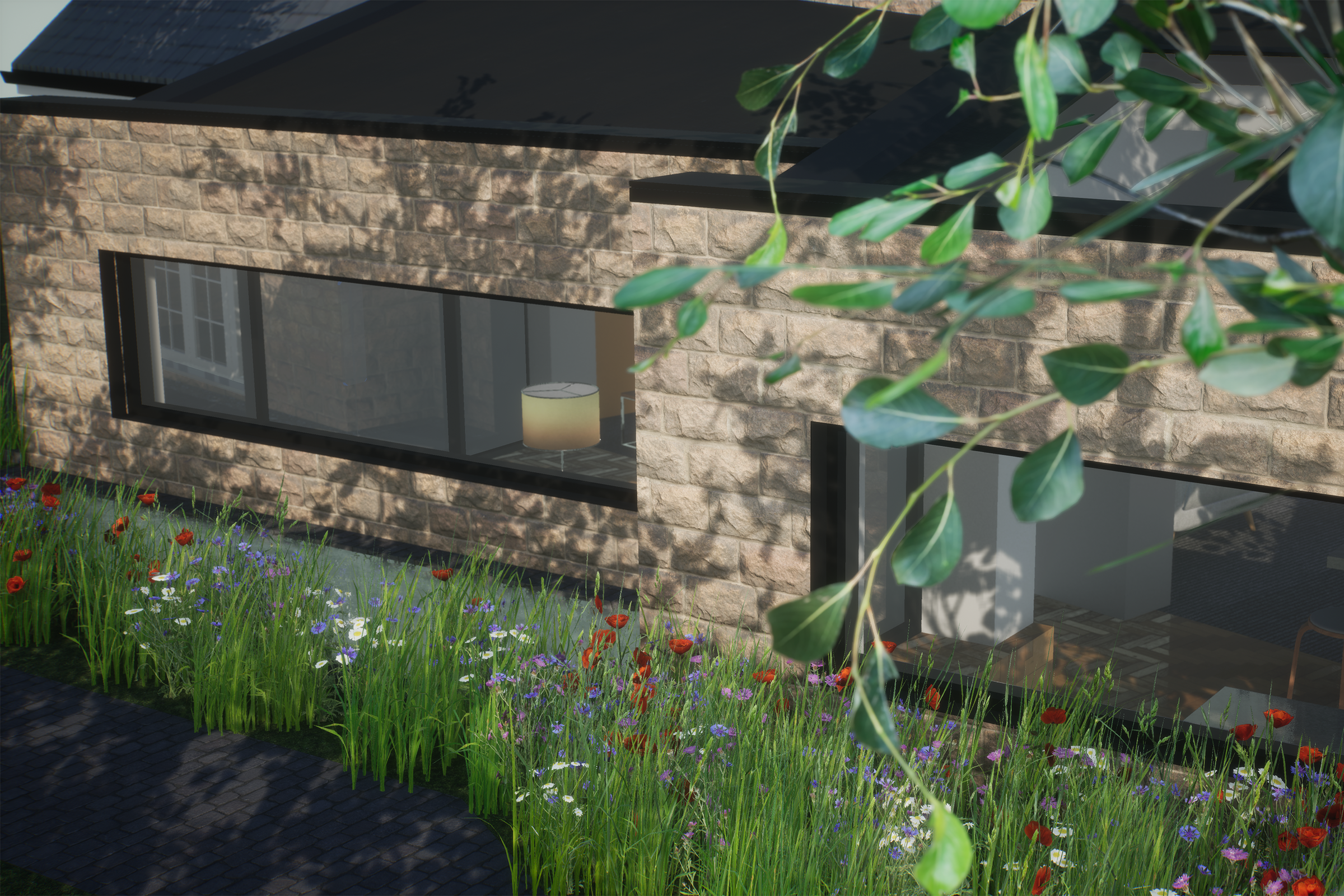
The stone textures (and other materials) within the model are of a high quality; these are obtained from the Quixel Megascans library, as a plugin to Unreal Engine.
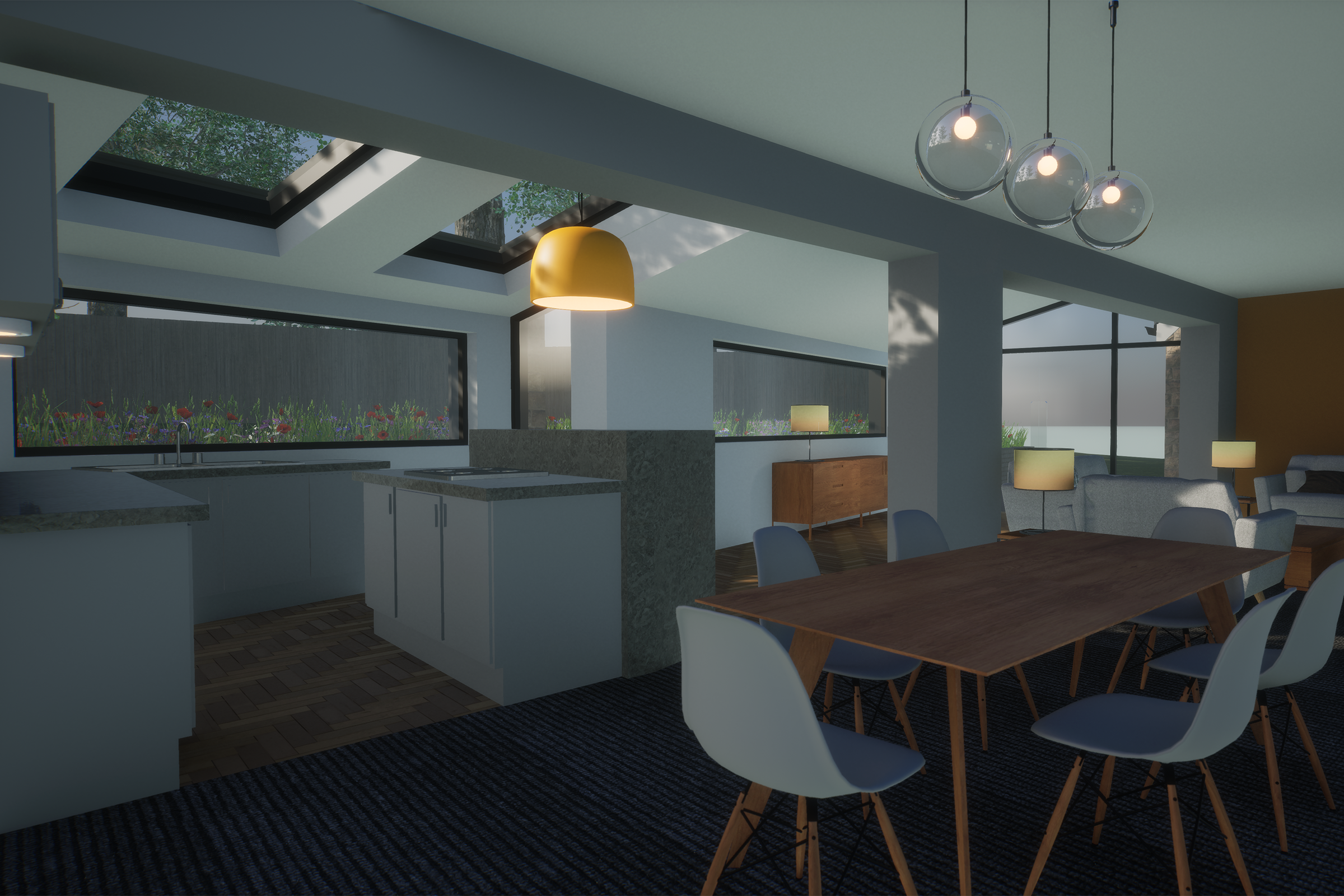
In this Option 2 version of the model, the smaller picture windows of the previous iteration have been replaced with a larger window in the kitchen space.
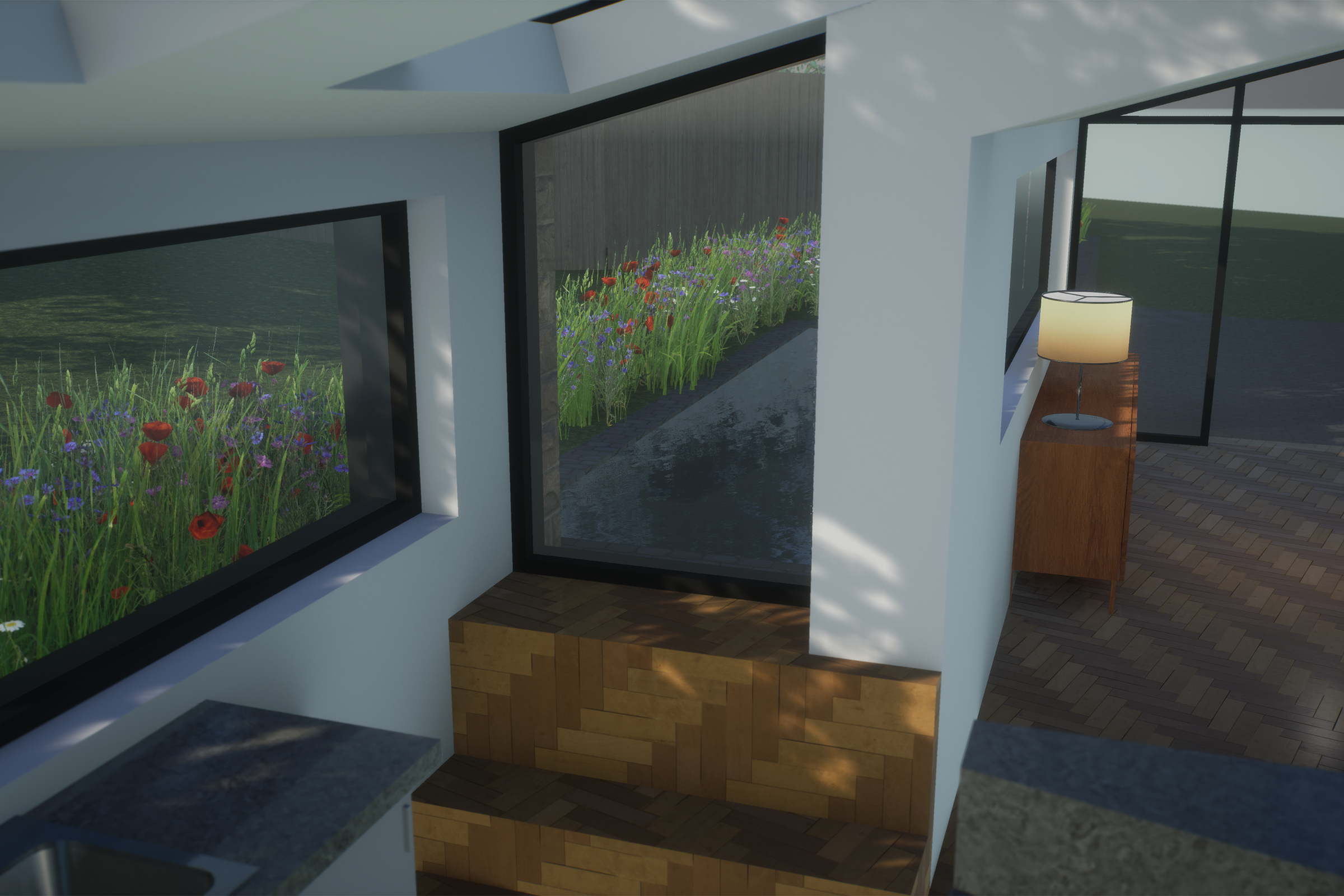
The floor material is stepped up to form a window seat; the occupants can sit by the pond and talk in the kitchen area.
The key aspect of that quandary, is to what extent we’re able to use the data that we’d generate anyway. Are we having to produce entirely different data-sets for visualisation? In every case that we’ve looked at, we’ve been able to export from our standard 3D model and import via Blender into Unreal Engine. Based on the results of our experiment with Unreal Engine so far, I believe we’ve found a way to produce more realistic and immersive visualisation; it will allow us to provide even better value architectural services to our clients.
When I first started my own practice back in 2009, I wanted to ensure that at the core of the business, we had the technology that would allow us to create architectural prototypes of our proposed buildings / proposals. Unreal Engine has brought a new strand to a process that I expect we’ll continue to refine over the coming years and decades, as we seek to make our architecture, our practice and ourselves, the best versions that we can be.
For the first time in a long while, the business of the day has felt like practice again, in the true sense.
Prologue
This four part blog series has been written over a period of ten months. I wrote the first three parts in a couple of afternoons, in a little holiday apartment in Eyemouth, Berwickshire. Although I knew that I wanted to write about Convergence, Film, Gaming and Architecture, knowing how to start and how much detail I should include took some time and exploration of concepts.
As I was thinking about why these subjects are in any way important, I started to think about what a privilege it is when your job is something that you genuinely love to do. For me, architecture is like that some of the time – there are moments of deep satisfaction, often sandwiched between long periods of dogged determination and the discipline to keep unravelling problems and weaving solutions.
The project work that I undertook using Unreal Engine took a lot of time, and much of that was after normal working hours and into the early hours of the following day. It made me appreciate the state of flow in which we sometimes find ourselves as professional people. I came across a helpful TED Talk from Mihaly Csikszentmihalyi entitled Flow - The Secret to Happiness – I commend it to you.
Flow - The Secret to Happiness
What is flow?
Completely involved in what we are doing – focussed, concentrating.
A sense of ecstasy – of being outside of everyday reality.
Great inner clarity – knowing what needs to be done, and how well we are doing.
Knowing that the activity is doable – that our skills are adequate to the task.
A sense of serenity – no worries about oneself, and a feeling of growing beyond the boundaries of the ego.
Timelessness – thoroughly focussed on the present, hours seem to pass by in minutes.
Intrinsic motivation – whatever produces flow becomes its own reward.






